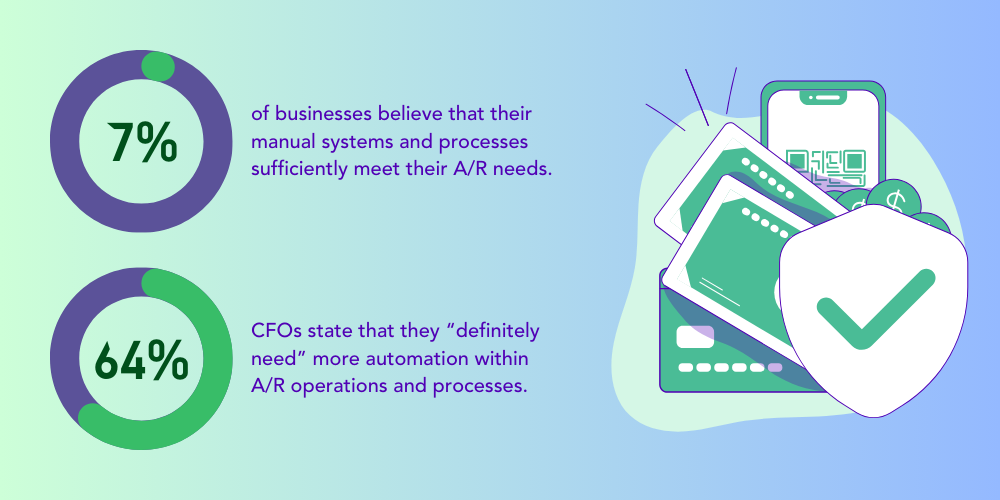Contact Sales (402) 933-4864
Contact Sales (402) 933-4864
Written by: Ashton Steffl

In today’s digital age, payment acceptance technology across the B2B landscape has increasingly evolved to fit the demands of businesses and customers alike—pushing electronic payment methods and channels to the forefront across businesses’ accounts receivable (A/R) and payment processing operations. This rapidly changing technological landscape has brought on an evolution of new payment technologies including the ability for businesses to seamlessly embed payment acceptance capabilities into their existing interfaces, web pages and mobile applications.
In this article, we’ll explore the growth of embedded payment technology and highlight the crucial role of application programming interfaces (APIs) in enabling businesses to accept payments more efficiently and securely.
The Evolution of Embedded Payment Technology
Embedded payment technology refers to the integration of payment acceptance capabilities directly into various platforms, interfaces or applications. The rapid growth of e-commerce and the increasing demand for frictionless payment experiences have driven the adoption of embedded payment solutions across industries.
Traditionally, businesses relied on standalone payment gateways or external processors to handle payment acceptance. However, embedded payment technology eliminates the need for customers to redirect to external payment gateways, providing a seamless checkout process that enhances the user experience. This technology enables customers to make purchases and/or payments without leaving the platform or application they are using, increasing convenience and reducing friction.
APIs are Helping Businesses Streamline Payments
APIs play a pivotal role in facilitating the smooth integration of embedded payment technology into businesses' existing systems and applications. An API acts as a bridge between different software applications, allowing them to communicate and share data securely and efficiently.
The use of APIs and web service integrations for accepting in-app or in-platform payments continues to proliferate within businesses spanning a broad range of industries including financial services, distribution and logistics, staffing, healthcare, property management, field services, insurance, nonprofit, real estate and more.
APIs provide an efficient and standardized way for businesses to connect their systems with payment technology providers while retaining the flexibility to connect to any processor, banking institution, and back-office system to enable a seamless payment experience, securely transmit data between systems, automate the cash application process, and deliver enhanced reporting capabilities. By integrating payment APIs into your existing platforms and mobile applications, your business can accept a wide range of payment methods, including checks (via mobile remote deposit capture), ACH/EFT, credit cards, digital wallets, and alternative payment solutions.
So, why APIs?
One significant advantage of using APIs for payments is the flexibility they offer. Businesses can choose the level of integration that suits their needs, from simple checkout buttons to complete white-labeled solutions. APIs also provide developers with the tools and documentation necessary to customize the payment experience and tailor it to the specific requirements of the business.
Furthermore, APIs can facilitate the management of recurring payments and autopay (automatic debit) enrollments. They enable businesses to automate billing cycles, manage customer information securely, and automate the process of cash application into any back-office system. This streamlined process not only reduces internal administrative burdens, but also improves the overall customer payment experience.
As businesses continue to be forced to evolve with the demands of a rapidly changing payment environment, the importance of efficient and automated processes within A/R operations is a necessity. APIs and embedded payment acceptance integrations might be just what your business needs to take the step towards modernizing your payment acceptance and back-office cash application operations.
Below are four ways APIs and Embedded Payments can help accelerate your payment acceptance and A/R processes.
1. Increase Efficiency from Payment Acceptance to Back-office Posting
One of the primary benefits of embedding API-driven payment acceptance technology within your applications and interfaces is increased efficiency across your A/R organization. APIs help businesses to significantly streamline and automate payment acceptance, processing, management and posting, all from a single, secure solution. By integrating payment acceptance technology into your existing applications and interfaces, your business is able to consolidate payment processing operations to a single platform. In turn, this helps to reduce manual intervention needed by your A/R team to handle incoming payment information. With all payment methods and channels flowing through a single user-interface, your organization is able to accelerate payment processing and cash application operations.
APIs and web service integrations also deliver increased efficiency by automating cash application operations to any-back-office system. Seamlessly embedded payment acceptance technology allows your organization to automatically associate customer information and payment details to your back-office systems in real-time. Eliminating the need for manual, time-consuming, error-prone, A/R tasks such as data entry allows your internal A/R team to focus on higher value functions within your organization instead of manually processing and posting payment details.
By allowing your business to seamlessly embed payment acceptance technology into existing software and solutions, your A/R organization is able to manage all payment activity from one location, with the added benefit of complete oversight across all payment methods and channels. When looking to leverage seamlessly embedded payment technology, strong consideration must be placed on the time and resources your organization will be able to save.
2. A Better Payment Experience for Your CustomersAPI technology also delivers a better payment experience for your customers. By seamlessly embedding payment acceptance capabilities into existing interfaces and applications, your customers can continue to utilize familiar web pages and applications with the added benefit of now being able to quickly and securely make a payment to their account. For example, with online payment acceptance APIs, customers are able to easily make electronic payments online via your existing website or customer portal without ever leaving your business’s user environment. No manual intervention is needed from your A/R team, and customers don’t have to login, logout and login again to multiple interfaces to simply make a payment on their account.
Overall, payment acceptance APIs will help to improve customer satisfaction by providing a seamless user experience, leading to repeat business and increased revenue for your company. In turn, this helps to accelerate your A/R operations by allowing customers to pay sooner, reducing DSO, and increasing cash flow for your business.
3. Streamline Cash Application Capabilities with Any Back-office System to Save Time and CostAPIs not only deliver convenient payment acceptance capabilities, but also flexible connectivity to integrate with any back-office system to streamline cash application and reconciliation operations. API and web service technology allow seamless integrations between different software applications, platforms and back-office systems, making it easier for businesses to integrate and manage A/R operations from a single solution.
By utilizing APIs and web services to streamline your back-office cash application operations, you are able to post payment details to any back-office/CRM/ERP system in real-time. Your A/R team no longer has to manually key in payment details, and all payment data is automatically associated with customer information and posted to your back-office system(s).
Like we always say, each time your A/R team has to manually review a payment, it costs you money! With API and web service technology, your organization is able to save time and money by reducing the need for human intervention across payment processing and cash application operations.
4. Enhance Security and Compliance within Your Applications, Interfaces and A/R SoftwareSecurity and compliance is always a top priority when it comes to accepting and managing payment information. APIs and web services deliver a secure and reliable way to accept payments, as well as transfer data between software systems. By using secure encryption, tokenization, and authentication protocols, businesses are able to ensure that sensitive payment information is protected across all customers.
By utilizing API technology to seamlessly and securely accept payments across multiple channels, your business is able to reduce risk and implement proactive security measures. Your business can ensure payment acceptance and processing is secure and compliant across your entire organization, as well as industry requirements.
APIs can also assist businesses with following payment industry compliance requirements. Through the use of industry-standard encryption protocols and security measures, APIs delivered from leading payment technology providers help to protect sensitive payment data during transmission. Moreover, APIs can assist businesses in complying with Payment Card Industry Data Security Standard (PCI DSS) and NACHA requirements without the need for direct access to card or account holder data, helping to reduce the overarching scope of their compliance responsibilities.
____________________________
Now that we’ve covered some notable ways that embedded payments and APIs may be able to help your business, what do they actually look like in the day-to-day operations of your A/R organization?
At FTNI, the popular use-cases of seamlessly embedded API technology include online and mobile payment acceptance, as well as data integrations with any back-office system. With FTNI’s A/R automation platform, ETran, our suite of APIs and web services deliver your business with efficiently embedded payment acceptance capabilities that integrate with your existing interfaces so you can tailor the payment experience to your unique brand, business processes and back-office operational workflows.
In fact, across FTNI's 250+ customers spanning numerous industries including food service and beverage distribution, insurance, real estate, financial services, healthcare, field services, utilities and more, nearly 50% utilize APIs and/or web service integrations to securely accept payments within their own applications, or to streamline the transmission of data between one, or multiple, back-office systems for cash application and reconciliation purposes.
With online and mobile payment acceptance, ETran’s API technology seamlessly integrates with your existing website and/or mobile application to streamline payment acceptance. Your IT team is able to utilize FTNI’s API documentation to embed our payment acceptance technology into your website to allow customers to easily and securely make electronic payments online, as well as embed payment acceptance technology into your mobile app to accept checks, ACH/EFT and credit/debit card payments in the field. All payment information accepted through FTNI’s payment acceptance technology seamlessly flows through the ETran platform at the home-office to automate cash application operations.
In conclusion, embedded payment technology and the use of APIs are driving significant advancements in the way businesses accept payments and manage cash application operations. The growth of online commerce, the popularity of mobile apps, and the increasing demand for seamless transactions have all contributed to the ongoing proliferation of embedded payments across a growing number of industries. APIs play a vital role in enabling this technology, providing secure connections to solution providers, expanding payment options, and automating back-office operations. As businesses continue to prioritize customer experience and digital transformation, embedded payment technology and APIs will remain at the forefront of innovation, shaping the future of payments and the modernization of A/R operations.

The Proliferation of Electronic Payment Methods and Channels, Understanding Customer Payment...
Read More
There’s never been a better time to start taking advantage of the new technologies that are...
Read More
As we take a look at recent trends, data and what we are seeing with our own customers, a few...
Read MoreFinancial Transmission Network, Inc.
13220 Birch Drive, Suite 120
Omaha, NE 68164
Sales: +1 (402) 933-4864